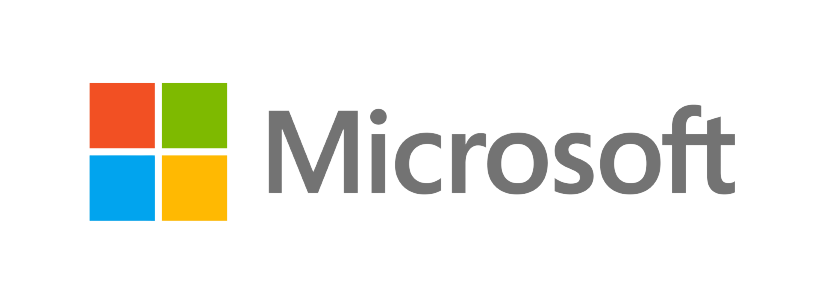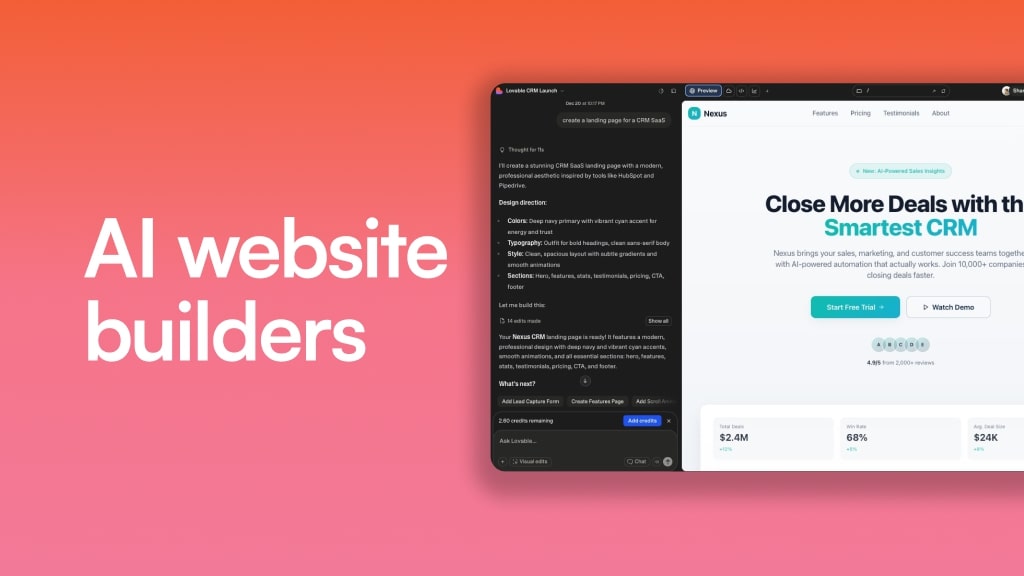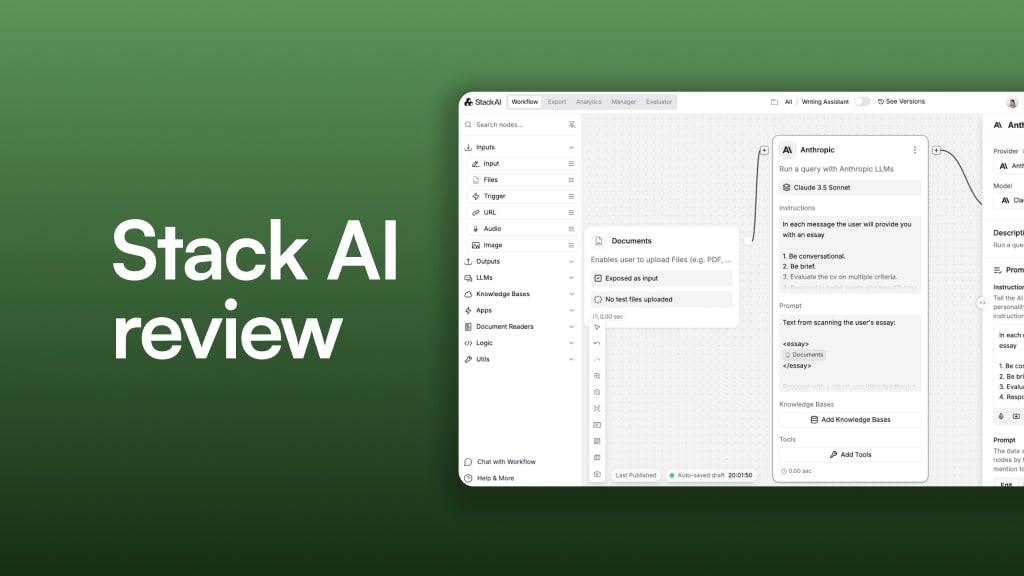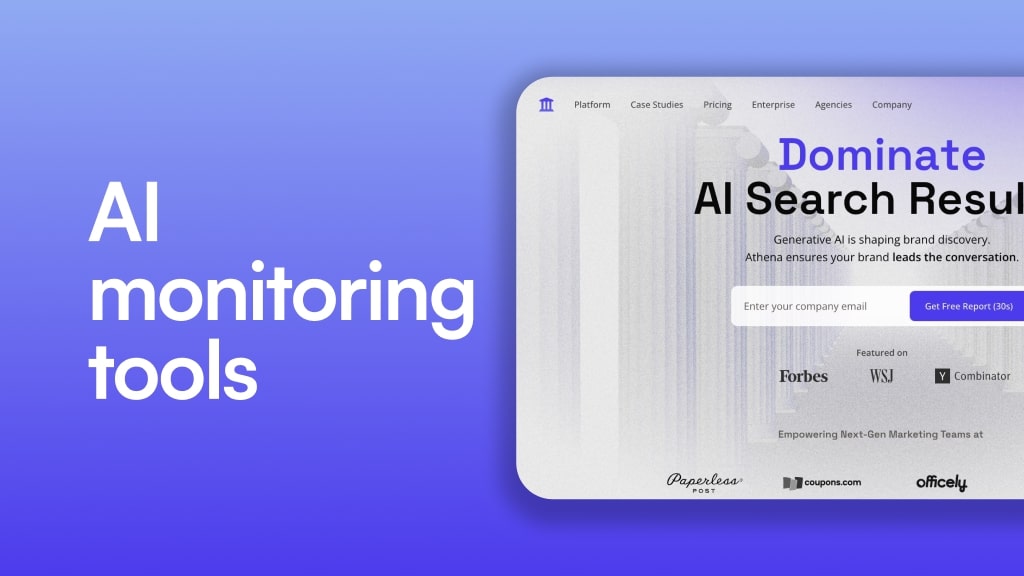I’ve been really skeptical about AI visibility trackers.
Given that there is no Google Search Console or Bing Webmaster Tools equivalent for LLMs and AI search engines like ChatGPT, Perplexity, or Claude, it’s really hard to trust any sort of AI tool that promises to track your visibility.
But, instead of turning a blind eye, I decided to try out over a dozen of these AI search tracking tools.
Most of them are wack. But, Peec AI has been one I find myself coming back to and actually recommending.
So I wanted to write an honest review of the platform. The company is not paying me to write this (and they don’t even know I’m currently typing all of this out).
I’ve been using the tool quite a lot so I’m going to go over what it does, who I think it’s best for, and give my final overall thoughts in the TLDR section at the very bottom of this article.
Okay no more rambling from me, let’s go over who I think this tool is best for.
Who is Peec AI for?
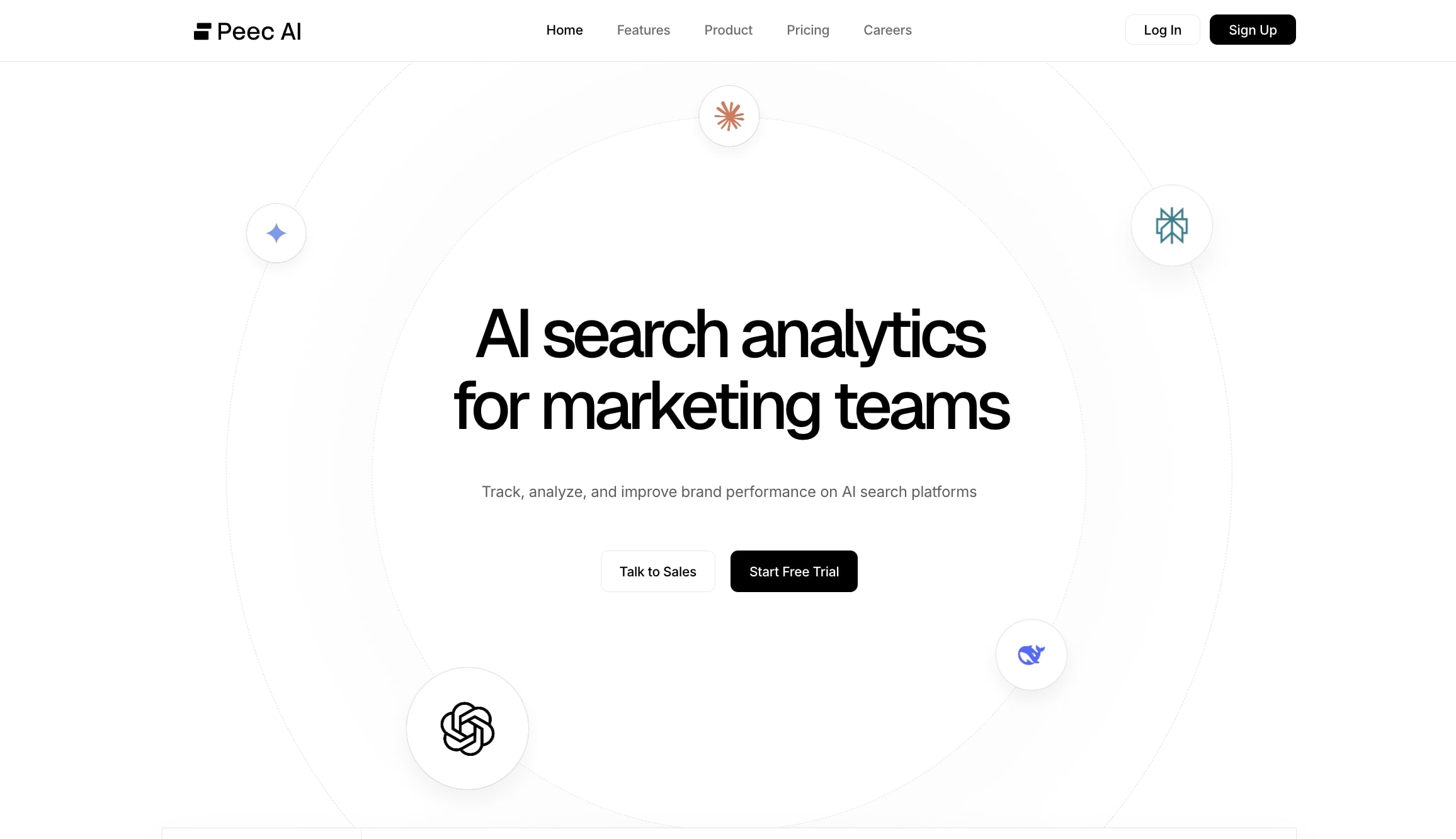
Peec AI is a new AI visibility tracker. It’s designed to help you understand how your brand is showing up in AI search engines like ChatGPT, Gemini, Claude, Perplexity, and DeepSeek.
It’s honestly great for any website that gets a decent amount of SEO traffic from Google already. If you’re a brand new startup, I don’t think you’ll get much value out of Peec AI or any other tool similar to it.
But if you’ve noticed that you’re getting more referral traffic from LLMs in Google Analytics, or you have customers telling you that they found out about your company through ChatGPT, then this is definitely a tool to check out.
It’s great because most AI monitoring tools charge hundreds of dollars just to start using them. And many of them don’t have a free trial or account for you to actually see how it works before you pull out your credit card.
But Peec AI has a free 7 day trial that lets you see its full potential. Which I think is already a plus about this platform (compared to others).
I’ve been using it to analyze my own website, the one you’re currently reading on, as it gets a lot of referral traffic from LLMs. But because of the nature of my site, a media website, I mainly show up in LLMs as citations.
The real benefit comes if you’re a brand that sells products or services. Think SaaS companies, agencies or service businesses, or ecommerce brands.
So I started to analyze some other “competitors” I had. These are mostly SaaS companies that blog about similar topics as I do. And that’s where I saw the magic the tool has.
Peec AI has a few core features inside the product that I think make it really easy to understand. And the UI/UX is pleasing to interact with.
Let’s go over some of those features and how they work.
Peec AI’s popular features
After using the platform, here are my favorite features the tool has. These aren’t just from what they say on their website. They are actually the features within my own dashboard that I think are notable call outs.
Speaking of dashboards, let’s get into the first one.
Dashboard
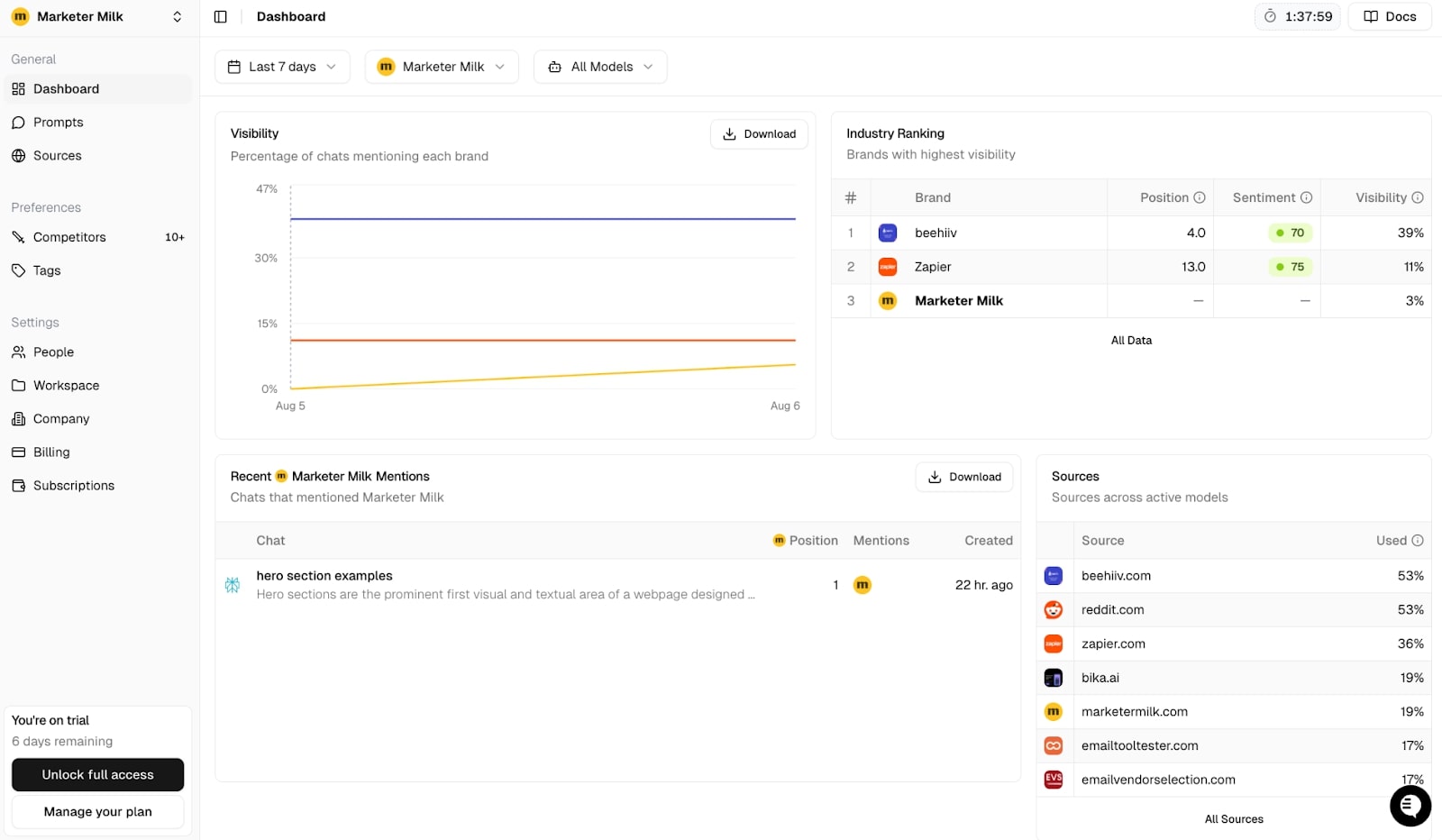
The dashboard is your control center. It’s great because I can get a birds-eye view of everything. It's important to note that this populates after you have added your website, competitor websites, and loaded up prompts to track (but I'll go over those features in a sec).
Right away, I can see the ‘Visibility’ section, which appears to be some sort of share of voice feature that shows my website across competitors I have added.
I can see ‘Industry Ranking’ which lists all the websites I have added, the brand name, the average position of the brand being mentioned (in the past 7 days), the sentiment (over the past 7 days), and also the visibility percentage (which is the percentage of chats showing the brand name over the past 7 days).
I can also see ‘Recent [your brand name] Mentions’ of my own brand/website, where it shows the prompts I'm tracking and their position and mentions. Along with ‘Sources’ where it shows the percentage of websites being cited for the prompts I'm tracking. All of this is front and center.
What I actually like about this:
- Everything important is visible immediately when you log in
- Clean, simple interface that doesn't feel overwhelming
- Quick competitor comparison right on the main screen
- Real-time sentiment tracking alongside position data
- Easy access to other features through the left sidebar
There's also a left hand sidebar that you can access the other features, with another big one being the ‘Prompts’ (which I'll get into in the next section).
What I really like about this setup is that I don't have to dig around to find the most important data. Everything I need to quickly assess how I'm performing in AI search is right there when I log in. It's pretty straightforward. In just a few seconds, you can tell if something's trending up or down and if there are any mentions you need to pay attention to.
Prompts
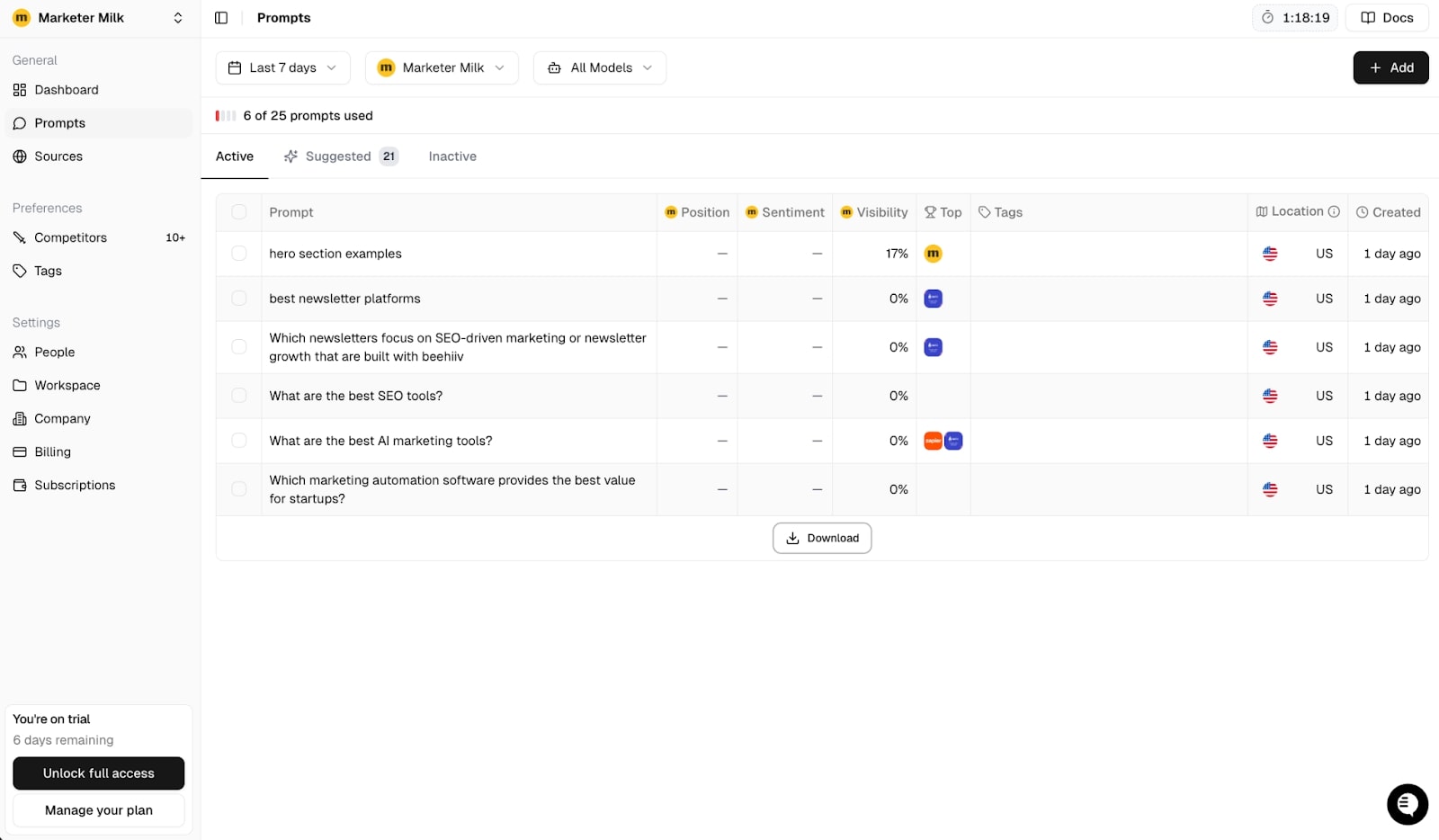
Most AI search visibility trackers require that you already know what prompts to track. Peec AI has this as well. If you have an idea of what prompts your potential customers are searching for, you can add them to be tracked.
But what made me love Peec AI over other tools was that it has a 'Suggested' tab that gives you prompt ideas based on keywords and topics your website is about. In one click, you can generate all of these prompts and either reject or accept them to be tracked.
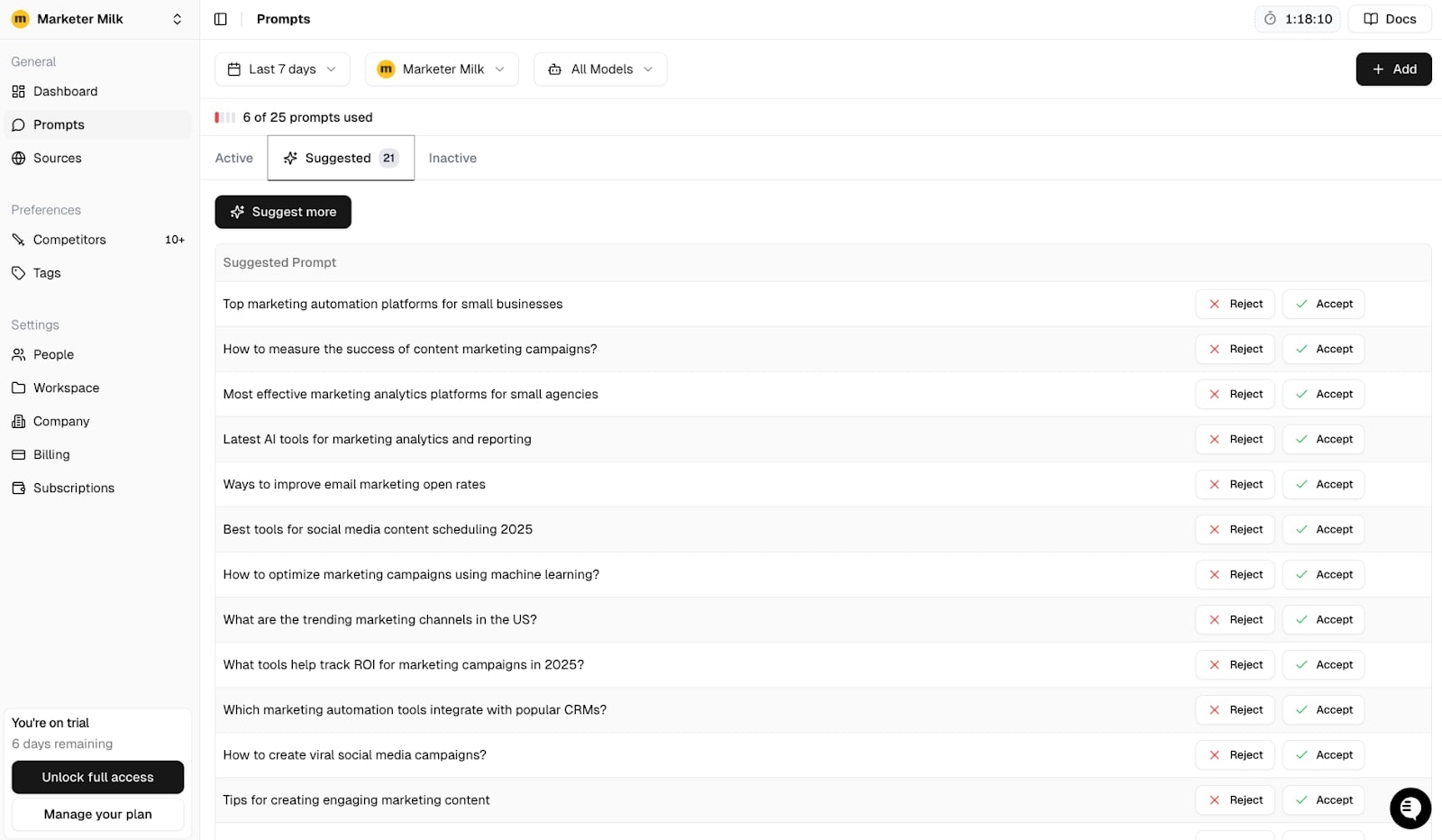
The cool thing is you can also change the timeline for how things are tracked. For example, Peec AI loves to default to a 7 day analysis. But you can change this to 14 days, 30 days, or any custom timeline.
It's important to note though, that this timeline can only work based on how long you have been using the tool. You cannot retroactively look at data that has not been tracked initially in Peec AI. So if you signed up 2 days ago, you only have access to data from today up until 2 days ago. On the same token, if you have been using Peec AI to track stuff for the past 3 months, you can look at any window of time in the past 3 months.
What I like about this feature:
- Suggested prompts feature helps you guess less on what to track
- One-click prompt generation with easy accept/reject options
- Flexible timeline analysis (7, 14, 30 days, or custom ranges)
- Comprehensive data view showing position, sentiment, visibility, and location
- Custom tagging for prompt organization
- Easy CSV download for all your tracking data
In the Prompt tracking dashboard, you can also see all of the active prompts you're tracking. This is focused heavily on your own brand you are tracking, so you'll see things like your position, sentiment, visibility, location, and any custom tagging attributes you add to prompts for organization. There is also a ‘Top’ column that shows you and any other competitors you have added. You can also one click download all of this data, and it downloads as a CSV.
Sources

The next big feature is the 'Sources' tab in the left sidebar. And in that feature, there are Domains and URLs tabs.
In Domains, based on a combination of prompts you're tracking and competitors you have added, you can see all of the individual brand domains. In the table, there is a 'Type' column (which explains what the domain is, like a competitor, your brand, reference citation, corporate companies, UGC websites like Reddit, and editorial bloggers).
In the same table, there's also a ‘Used’ column that shows the percentage of chats using the source in the last 7 days. Lastly there's an ‘Avg. Citations’ column that shows a numbered decimal of the average number of citations used from the source in the past 7 days.
At the top, there's also a graph that shows you trending data of all sources. It's super neat but some of the colors are very similar so it can get confusing on what each source the line is. You'll have to hover over the lines to see it populate what source equates to what colored line (like I did in the screenshot above).
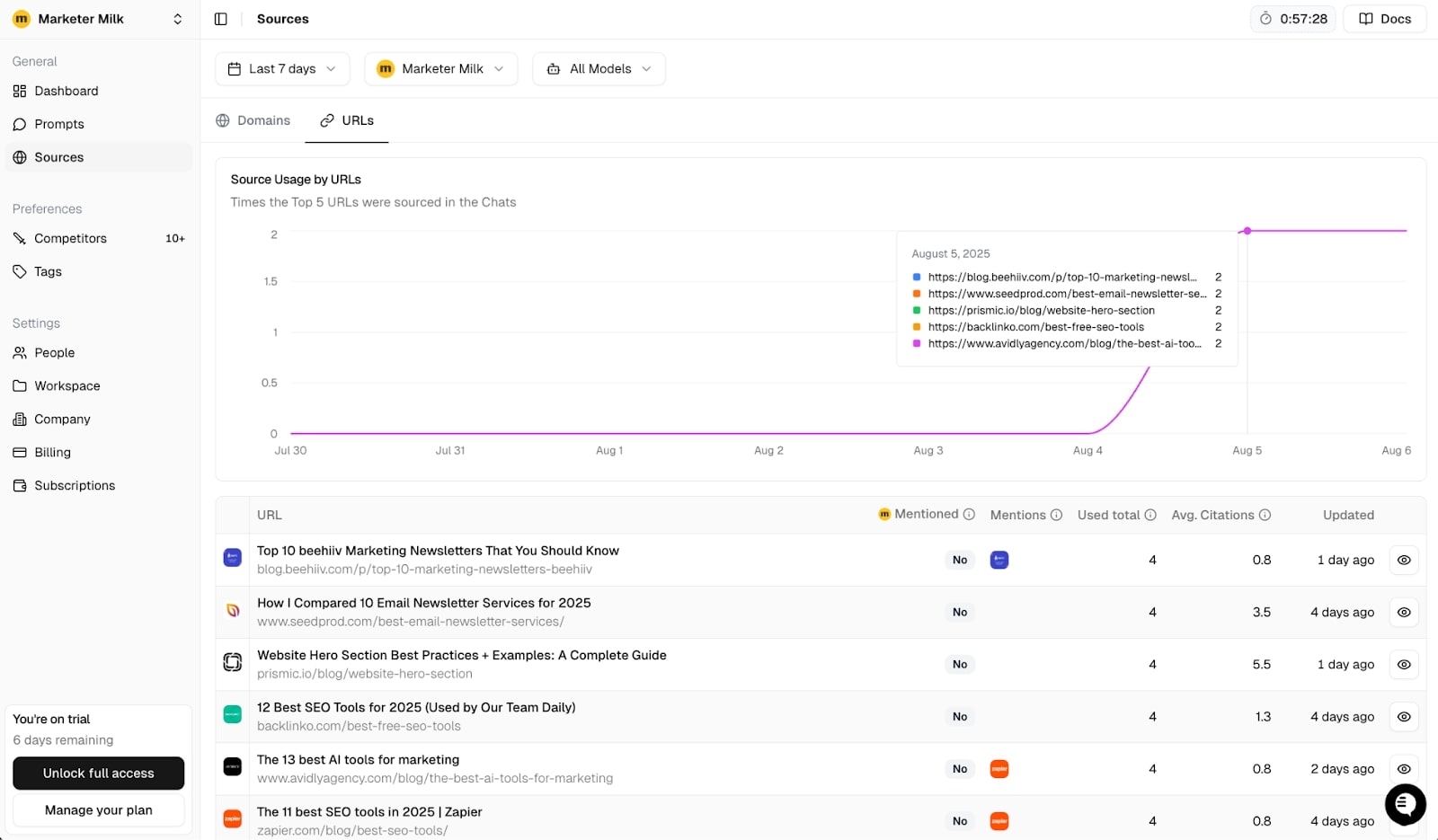
In the prompt feature, there's also a URLs tab. This shows you the exact web page URLs from the sources that are being used. This is so sick. I actually think this is more useful than the ‘Domains’ tab. I don't know why they didn't make this the initial tab the ‘Sources’ feature loads with.
What I like about this feature:
- Clear categorization of source types (competitor, brand, citations, UGC, etc.)
- Percentage breakdown of chat usage for each source
- URLs tab showing exact web pages being cited (great for outreach)
- Yes/No mention tracking to identify potential partnership opportunities
- Easy identification of competitor mentions in source URLs
- Last updated timestamps so you know how fresh the data is
The URLs tab also has a graph, which is again a bit confusing. Actually this one is more confusing than the ‘Domains’ tab graph because it's just one line. And you have to hover over the single line to see the individual URLs (like I did in the screenshot above). I imagine the UI would get funky in the graph which is why it's just one line, but it is a little weird if I'm being honest.
After all, this is an honest review.
The bottom table that shows the individual web pages also has a few columns. The first one is a simple Yes or No response that says if you are being mentioned in the individual web page. This is probably the most valuable column if you're a large brand trying to find blogs to reach out to to mention you.
There's also a ‘Mentions’ column which will only show websites you have added as competitors. It will show which one of your competitors are being mentioned in the web page sources.
And there's a ‘Used’ total column that shows how many times the URL was used as a source (I imagine this means how many times the URL was used as a citation for a given prompt). There's also an Avg. Citations column (which I'm still a bit confused about) and there's an ‘Updated’ column that shows you the last time the source URL was scraped and updated.
Competitors
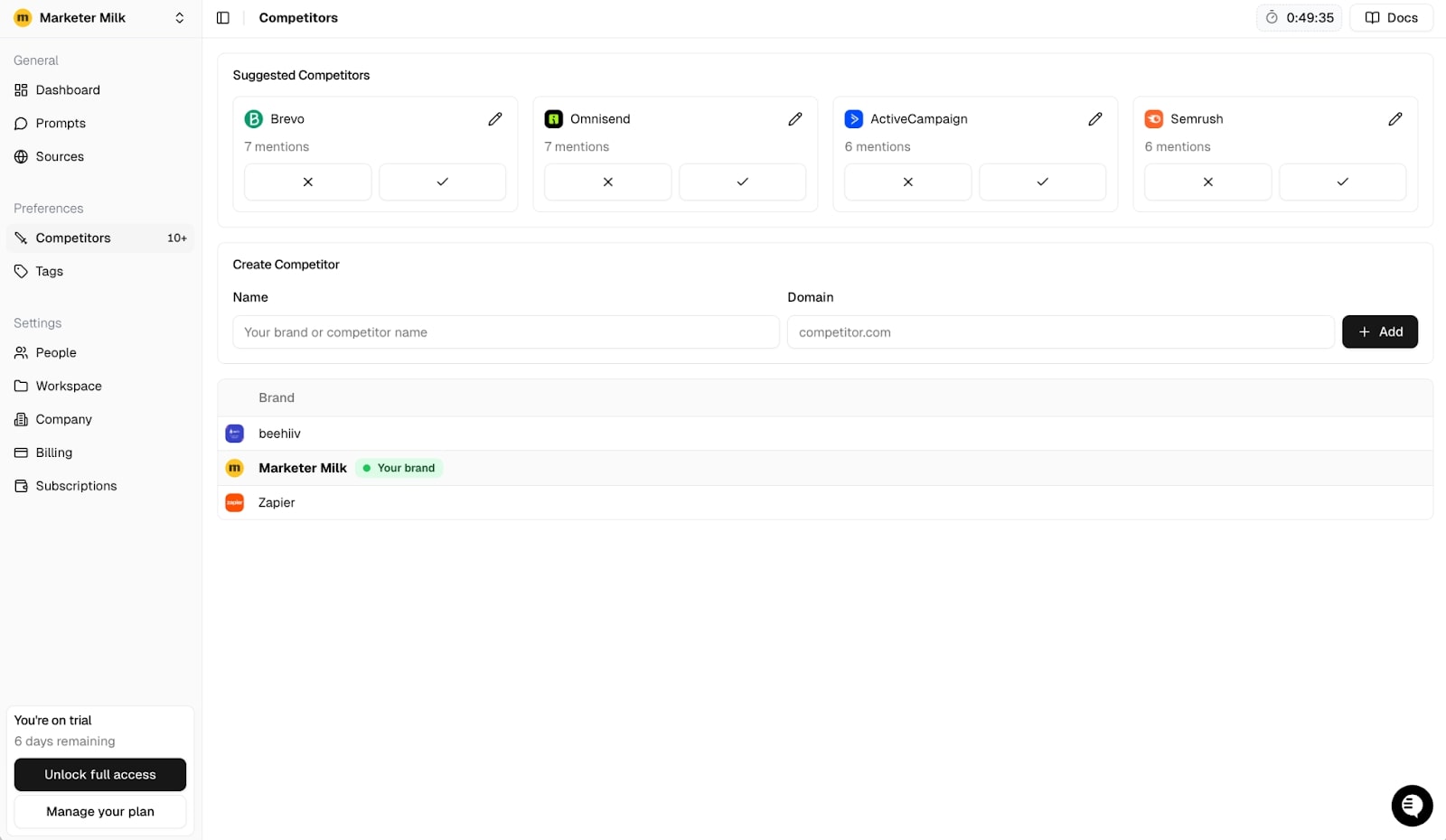
And lastly, there is a ‘Competitors’ tab in the left sidebar. This is where you can add competitors manually. There are also a handful of suggested competitors you can add which is really useful.
This table is simple. Just fill out a competitor's brand name, paste their domain, and click the “+Add” button to add them to be tracked and monitored. As you can see (in the screenshot above), I currently only have two competitors tracked, along with my own brand. But you can imagine how rich this data can get when you add dozens of competitor sites.
What I like about this feature:
- Simple, straightforward competitor addition process
- Suggested competitors feature saves research time
- Easy to scale up by adding more competitors over time
- Feeds into all other features for richer comparative data
- Part of the smooth onboarding experience
Overall, this feature feeds all the rest. And leads to you having a great Dashboard. This feature is actually one of the first features you interact with in the onboarding process. But you can always come back to this tab and add new competitors as they come up.
And that's it for the main features! There is one more feature tab called ‘Tags’ but I’m not going to write a whole section on that because it’s just a simple internal tagging feature you can use for organization.
Overall, you can see Peec AI has all the features you really need. I’m sure they’ll add more over time. But so far, this layout makes the tool really simple and easy to use. I’m surprised that the learning curve was so low for me personally.
Also, I don’t know if you noticed the countdown timer in all of my screenshots.

At first, this gave me anxiety watching it go down because I didn’t know what was gonna happen. Was something about to explode? But hovering over it, it shows that it’s just when the next prompt refresh is going to happen. I thought this was neat cause it shows how up to date all the data is.
To the team if you end up reading this: please make users better understand what this timer means and why it’s important.
How much does Peec AI cost?
Okay, let’s talk costs. These AI visibility trackers are historically not cheap. You’ll see people in the SEO community all over LinkedIn and X (Twitter) complaining that the prices are too high.
But surprisingly, Peec AI is actually affordable for what it does. It’s a typical credit pricing model that most AI SaaS products use. It also comes with extra add-ons that will increase your monthly bill.
Let’s look at the plans.
Peec AI’s pricing plans
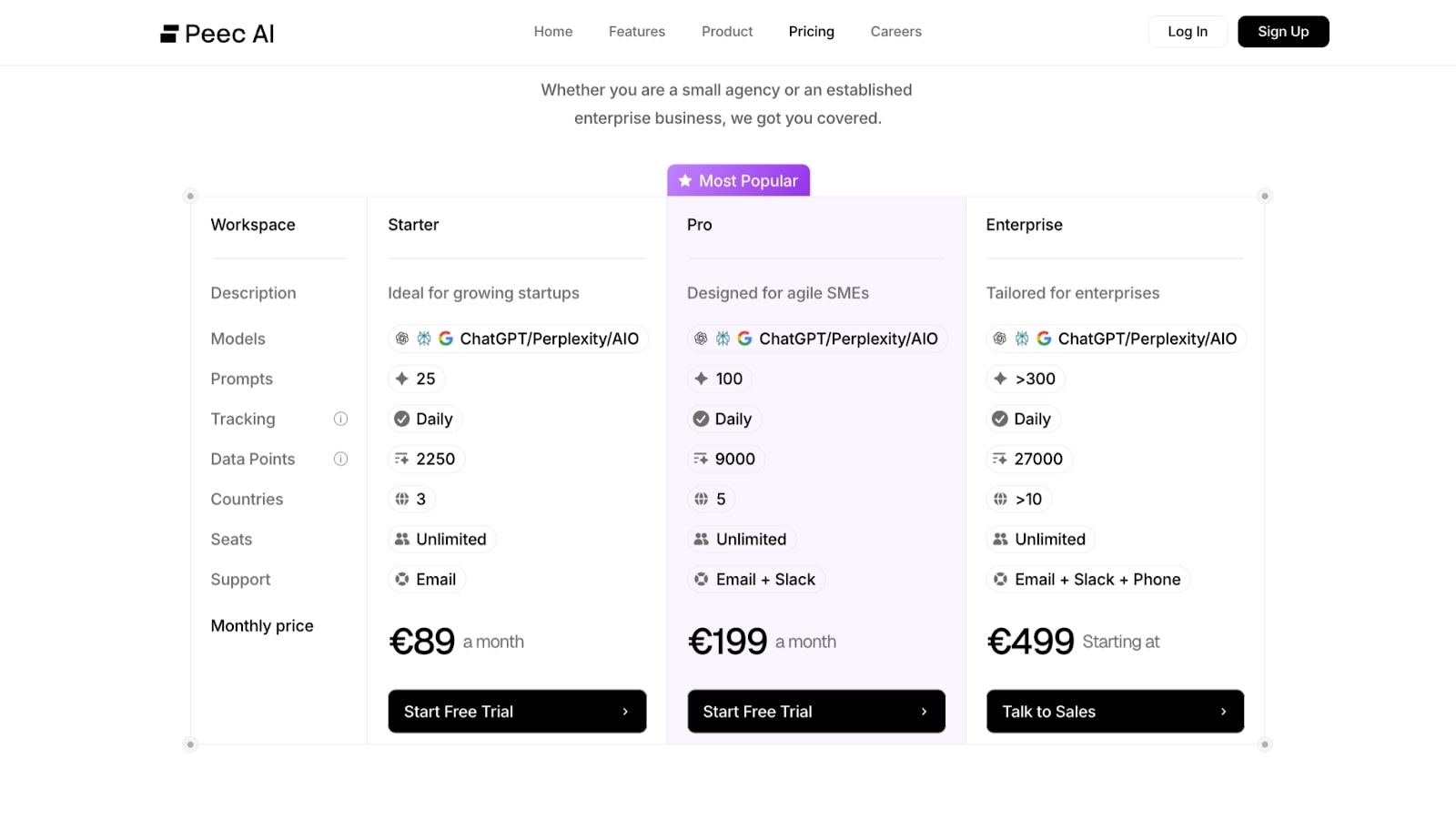
Here are Peec AI’s pricing tiers:
- Starter: $89/month. Comes with 25 prompts tracked, 3 countries, ChatGPT/Perplexity/AIO tracking, unlimited seats, email support
- Pro: $199/month. Comes with 100 prompts tracked, 5 countries, ChatGPT/Perplexity/AIO tracking, unlimited seats, email + Slack support
- Enterprise: $499/month: 300+ prompts tracked, 10+ countries, ChatGPT/Perplexity/AIO tracking, unlimited seats, email + Slack + phone support
Their Enterprise cost is what most tools in this space charge for their entry level plan, which is insane.
This makes the Starter plan, at $89 per month, reasonable compared to other AI visibility trackers I have tested. You get 25 prompts to track across 3 countries, which is enough for most small businesses or personal brands to get started. The fact that all plans include unlimited seats means you can add your entire team without worrying about per-user pricing.
What I really appreciate is the transparency in their pricing. No hidden fees or surprise charges that you often see with other SaaS tools. All plans come with daily tracking and access to the same core features, you are just paying for scale as you need more prompts and countries to monitor.
For the most detailed breakdown of what's included in each plan, check out their pricing page.
Peec AI’s customer support
In every review I do, I like to include customer support as a topic of discussion. I think it’s extremely important for SaaS products to have amazing customer service.
Given the whole vibe-coding trend, there are a lot of SaaS companies popping up and it can sometimes be hard to know which companies have a legit team behind it or if it’s just one dude in their mom’s basement.
Peec AI is still a new company with a small team. But it’s a very talented team. They have a CEO (duh), CTO, CMO, growth person, chief of staff, writers, and dedicated customer experience person. It’s a full team.
And when it comes to customer support, they’re quick to respond to any and all inquiries. There’s also a chatbot within the product that you can interact with if you need quick answers.
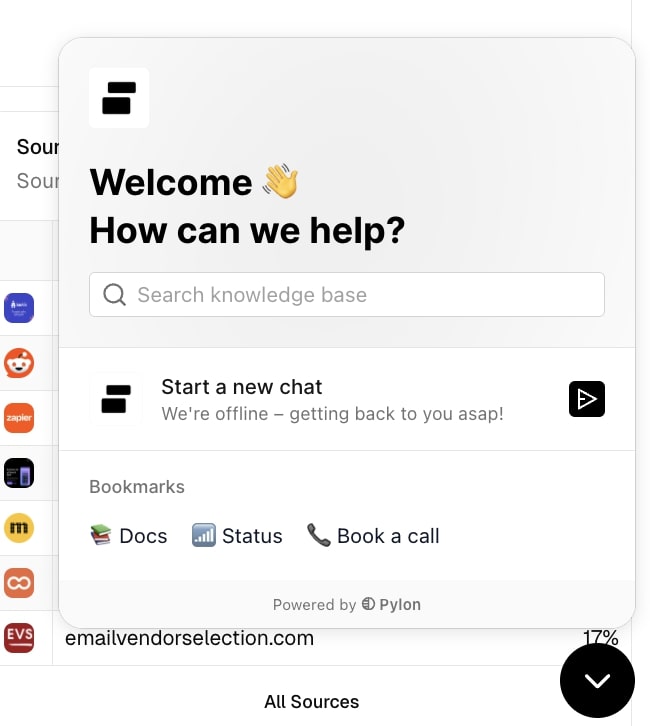
And if you want to talk to a real human, you can easily book a call with them. When you sign up, there’s also a welcome email from the CEO, Marius, that you can simply reply to if you have any questions (it’s his personal email).
One thing I do wish, however, is that they had some sort of community forum. Maybe they’ll launch one in the future, but it would be nice to interact with other users and see how they’re using the platform. A few SaaS companies have this model and I think it’s great.
But overall, I would say the customer service is at the level it needs to be for the stage Peec AI is in.
Peec AI’s scalability (and security)
Peec AI scales pretty well based on their tier structure. You can start small with the Starter plan and work your way up as your tracking needs grow. I have not had any issues with the platform glitching out or being slow, even when running multiple prompts and checking data multiple times a day.
The interface handles the data smoothly, and I have not experienced any downtime during my testing period. The unlimited seats across all plans is also a nice touch for teams that want to scale without worrying about per-user costs.
As for security, that's a bit of an unknown for me. I'm sure the platform is secure, but I don't see SOC 2 compliance mentioned anywhere, which is pretty standard for US-based SaaS companies.
Since they are based in Berlin, it might not be a focus area for them, or they might be following different European compliance standards. If security certifications are important to your business, you might want to reach out to their team directly to ask about their security practices and compliance status.
Peec AI pros and cons
After spending time with Peec, here's my honest take on what I like and don’t like.
Peec AI pros
Here’s what I like about Peec AI:
- Suggested prompts feature: This saves tons of time by automatically generating relevant prompts based on your website content.
- Free 7-day trial: Unlike competitors that charge hundreds upfront, you can test the full platform before paying.
- Great user interface: It’s easy to navigate with everything important visible on the main dashboard.
- Comprehensive competitor analysis: You can track multiple competitors and see exactly how you compare with them.
- Detailed source tracking: You can see which exact URLs are citing your brand, perfect for outreach opportunities.
- Flexible timeline analysis: You can adjust tracking periods from 7 days to custom ranges based on your needs.
- Transparent pricing: There are no hidden fees or surprise charges, just straightforward tier-based pricing (with optional add-ons).
- Unlimited seats: You can add your entire team without per-user costs across all plans.
- Multi-platform coverage: The platform tracks ChatGPT, Perplexity, Claude, Gemini, and DeepSeek in one tool.
Peec AI cons
Here are some things I don’t like about Peec AI:
- Limited value for new startups: This tool is best for established sites that already get decent SEO traffic (and solid branded searches).
- Confusing graph visualizations: In some graphs, similar colors make it hard to distinguish between different sources and data lines.
- No retroactive data: You can only view data from when you started tracking, not historical performance.
- Security compliance unclear: No mention of SOC 2 or similar certifications that US enterprises often require.
- Some features feel incomplete: URLs tab graph is just one confusing line instead of detailed breakdown.
- No community forum: I don’t see any mention of a user community for sharing best practices and tips.
- Timer anxiety: The countdown timer can be confusing without proper explanation of what it means.
Overall, I do think the pros outweigh the cons if you’re serious about monitoring how your brand is being recommended in AI search engines and LLMs. It’s also fairly easy to use and within 30 minutes of using the tool you’ll understand all of its features.
But, it’s not going to tell you how to improve your rankings. In fact, most of these tools don’t. They exist to give you visibility on where you currently stand. If you want to grow, you’ll have to be a smart marketer and know what to do with all of this information.
TLDR: My final thoughts
Here's the thing about Peec AI: it's not really a magic solution that will instantly boost your AI search rankings. It's specifically designed for tracking and monitoring your brand's performance across AI platforms, and that focus makes all the difference.
Peec AI will work for you if you have two things (you need both):
- You're an established brand with existing SEO traffic and brand recognition
- You're already seeing referral traffic from LLMs or customers finding you through ChatGPT
I tell this to every marketer trying to test out a new AI marketing tool: You can't optimize what you can't measure.
If you're a brand new startup with zero brand recognition, then you won't get much value out of this tool. Sure, you can track prompts and see where you rank. But if your brand isn't being mentioned in AI responses anyway, then it's just vanity metrics.
The companies crushing it with Peec AI (Wix, Brevo, Superside) didn't stumble into success just by using the tool. They already had strong brands that were being mentioned in AI search. They just needed visibility into how often and in what context. And that's what Peec AI is for.
Is Peec AI worth it?
✅ Yes, if you're an established brand that already gets decent SEO traffic and you're noticing more referral traffic from LLMs. This is one of the few AI tracking tools that actually provides actionable data instead of just vanity metrics. The suggested prompts feature alone will save you hours of guesswork, and the source tracking is perfect for outreach opportunities. It’s a great addition to an AI marketing workflow.
❌ No, if you're hoping this tool will magically make your brand appear in AI search results or you're just starting out with minimal brand recognition. Peec AI shows you where you currently stand. It won't teach you how to get mentioned more often. If your brand isn't being mentioned in AI responses already, tracking zero mentions won't help you much.
What makes the platform unique?
The biggest difference between Peec AI and other AI visibility trackers is the suggested prompts feature and overall user experience. While most tools make you guess what prompts to track, Peec AI actually analyzes your website and suggests relevant prompts automatically.
Unlike other expensive AI tracking tools that charge hundreds just to get started, Peec AI offers transparent pricing with a full 7-day free trial. The interface is clean and simple, and you can understand everything in about 30 minutes instead of needing weeks to go through a learning curve.
The URLs tab in the Sources feature is also something I have not seen in other tools. Being able to see the exact web pages that cite your brand opens up real outreach opportunities that go beyond just vanity tracking.
Get the weekly newsletter keeping +30,000 marketers in the loop.



